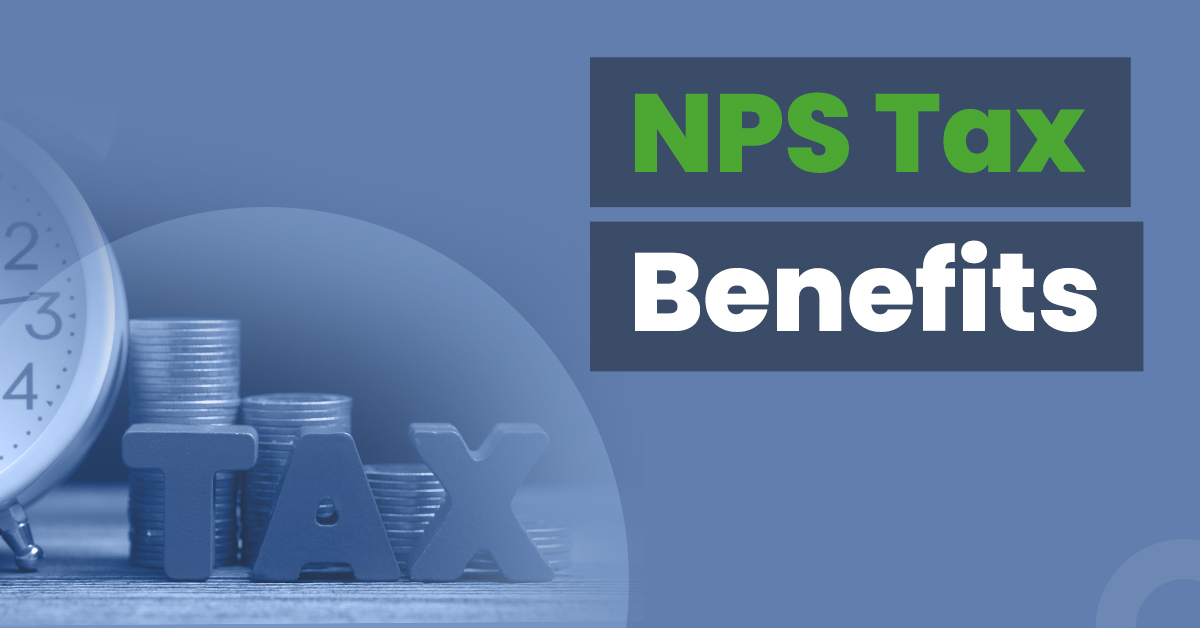NPS Tax Benefits: Everything To Know


Retirement is something we all tend to worry about. We spend a large part of our working years saving up for that time in the future when we will not be gainfully employed. To assist you in saving for your post-retirement years without any hassle, the Government of India introduced the National Pension Scheme (NPS) in December 2003.
NPS turned out to be an ideal investment avenue to secure and collect funds for the future. All you need to do is register and make regular and timely contributions. While government employees must partake in the scheme, private sector workers can also opt to register in the scheme. You deposit up to 10% of your basic salary into your account regularly after an initial contribution of ₹500 at the time of registration. The government pays a matching amount into the accounts of government employees.
The best part of the investment is the NPS tax benefits, besides the accumulated corpus. What are the NPS tax exemptions? How many NPS deduction sections are there in the Income Tax Act? Continue reading to find out more.
NPS Tax Benefits
You will surely be surprised to learn about the several NPS tax benefits. Registration in the National Pension Scheme guarantees you a sizable corpus for your imminent retirement and offers a host of tax benefits too. Let’s understand the various NPS tax exemptions to get a clear idea about the scheme.
1. Tax benefit to self-employed
If you are self-employed and an active investor in the scheme, you are eligible for the following NPS deduction in the Income Tax Act:
- You can get deductions up to 20% of gross income within the ceiling of ₹1.5 lakhs per Section 80CCD(1) and 80CCE, respectively.
2. Tax benefits to government employees
NPS is mandatory for government employees. If you work for the public sector, you can take benefit from the following tax savings:
- You can claim tax deductions up to 14% of your salary under the employer’s contribution within the ceiling of ₹1.5 lakhs per Section 80CCE.
3. Tax benefit to corporate employees
Private employees can register in the scheme if they wish to do so. It is not mandatory for them. However, once you start investing, you can claim the following NPS tax benefits:
- You will be eligible for deductions up to 10% of your salary under the employer’s contribution besides the ceiling amount of ₹1.50 lakhs under Section 80CCE, Income Tax Act.
4. Tax benefit on purchase of an annuity
- You have to buy annuity plans worth 40% of the accumulated funds. The mentioned percentage is eligible for tax exemption under Section 80CCD(5). However, any income you accrue from the annuities is subject to tax per Section 80CCD(3).
5. Tax benefit on lump sum withdrawal
- You will be eligible for tax exemption on lump sum withdrawal of 60% of the total corpus under Section 10(12A) after maturity.
6. Tax benefits on partial withdrawal from the account
- You can claim tax exemption in case of partial withdrawal of up to 25% of the self-contribution. However, it will only be applicable if you meet the specified conditions the Pension Funds Regulatory and Development Authority (PFRDA) has set for partial withdrawal.
Tier 1 Tax Benefits
Tier 1 account in NPS is a retirement plan with no flexibility. You cannot withdraw your funds in between the investment duration before attaining the superannuation. However, you can partially withdraw funds per the applicable rules and guidelines set by PFRDA. You have to make a minimum contribution of ₹1000 per year to keep the account active.
NPS Tier 1 account focuses on capital appreciation and accumulation. You can seek the following NPS Tier 1 tax benefits irrespective of what sector you are working in:
- You can claim tax deductions up to ₹1.50 lakhs under Section 80CCD(1) only if you have a Tier 1 account.
- The Budget 2017 permits 25% of the amount to be tax-free when withdrawn before maturity.
- The entire funds of Tier 1 are tax-free in maturity. You can withdraw 60% in a lump sum, with the remaining in the annuity.
- Tier 1 account makes you eligible for the additional deduction of Rs. 50,000 under Section 80CCD(1b).
Tier 2 Tax Benefits
Tier 2 is somewhat similar to a regular savings account. It is a voluntary account that lets you withdraw funds without restriction. However, you must possess a Tier 1 account to open a Tier 2 account. There is no minimum balance requirement for a Tier 2 account, and the minimum contribution is ₹ 250.
Furthermore, NPS Tier 2 tax benefits depend on the sector you are working in:
- Although any Indian resident and NRIs can invest in it, only government employees can claim the tax deductions of ₹1.5 lakhs under Section 80C.
- However, they must hold the account for at least three years to avail of this benefit.
- Meanwhile, if you are a private or self-employed, you do not get a deduction or exemption in your tax payable.
- The NPS Tier 2 tax benefits are restricted to government employees within the age group of 18 years to 65 years.
Additional Tax Deductions by NPS
There are numerous additional NPS tax benefits applicable to government and private sector employees. These are:
- Besides the ceiling of ₹1.50 lakhs, you can avail of ₹50,000 under Section 80CCD(1B) if you are an active NPS investor. This deductible amount is over and above the tax exemption in Section 80C.
- NPS tax exemption up to 10% of salary (basic + dearness allowance) with the available ceiling of ₹1.50 lakh can be claimed on your self-contributions under Section 80CCD(1) and 80CCE, respectively.
- The employer’s contribution is eligible for NPS tax deductions under Section 80CCD(2). You can claim 14% (if a central or state government employee) or 10% (if a private sector employee) of your salary tax deduction per this section.
- Employers and corporations are also eligible for a tax exemption on the employer’s contribution amount that they deposit or contribute to their employees’ NPS accounts. They can claim a deduction up to 10% of the salary, i.e., basic and dearness allowance, of the employer’s contribution as a business expense from the P&L (Profit and Loss) account per Section 36(1)(iv)(a).
Overall, you can avail of more than ₹2 lakhs of tax deduction. To understand the concept better, let’s take an example. Suppose you work at a corporation with ₹5 lakh as the basic salary and dearness allowance of Rs. 2 lakh. The table below shows all the NPS tax deductions in Income Tax available for you:
| NPS Deduction under which section | Amount |
| Salary | ₹5 lakh |
| Dearness allowance | ₹ 2 lakh |
| Tax deduction per section 80C | ₹ 1.5 lakh |
| Tax deduction per section 80CCD(1B) | ₹50,000 |
| Tax deduction per section 80CCD(2) | ₹70,000 for government employees and ₹50,000 for private employees |
| TOTAL | ₹2.7 lakh for government employees and ₹2.2 lakh for private employees |
Thus, the NPS provides you tax deductions of more than ₹2 lakh under the various sections of the Income Tax Act.
Final Thoughts
The NPS tax benefits extend to the entire corpus and the returns, all of which are tax-free, making the National Pension Scheme EEE (exempt-exempt-exempt). It is an excellent choice for accumulating funds as only a few schemes besides NPS offer the EEE tax status. The flexibility and low investment costs make the NPS all the more lucrative.
Frequently Asked Questions
How much tax exemption is there in NPS?
A total of Rs. 2 lakhs is exempted under Section 80C, Section 80CCC, Section 80CCD (1), and subsection 80CCD (1B). Additionally, tax deduction of up to 10% of pay (Basic + DA) for private employees and 14% for Government employees under Section 80 CCD(1) is available with a ceiling of ₹1.50 lakh under Section 80CCE.
How can I get ₹50,000 tax deduction in NPS?
You can access extra benefits by deducting up to ₹50,000 under subsection 80CCD(1B) in NPS’s Tier I account. It is above and beyond the deduction of ₹1.5 lakh accessible under Section 80C of the Income Tax Act, 1961.
Can I transfer my funds from Tier 1 to Tier 2 account and vice versa?
Transferring funds from Tier 1 to Tier 2 is not possible. However, you can deposit your amount from Tier 2 to Tier 1. Moreover, you can transfer your funds from the Employees’ Provident Fund account to Tier 1 if you desire.
What are the eligibility criteria for an NPS Tier 2 account?
You can apply for a Tier 2 after opening Tier 1. In addition, you would have to meet the following criteria to be eligible for the account:
a) You can open a Tier 2 account if you are an Indian citizen, resident, or even an NRI.
b) You should be aged between 18 years and 65 years.
What are the rules for partial withdrawal in the National Pension Scheme?
You can opt for partial or premature withdrawal for the following reasons, provided you have been an investor for at least three years:
a) Children’s higher education
b) Treatment of a critical illness (specified under PFRDA guidelines)
c) Children’s marriage
d) Purchasing a residential house (after meeting some conditions), etc.







